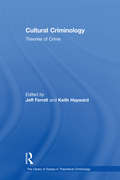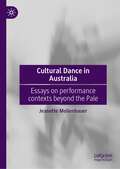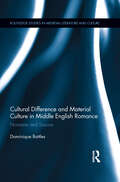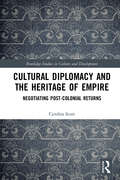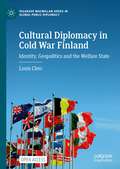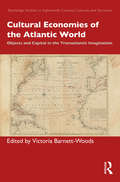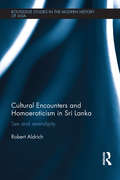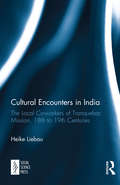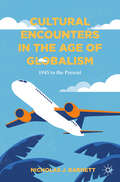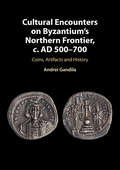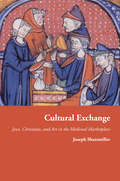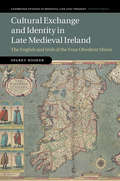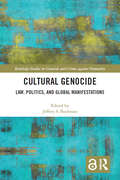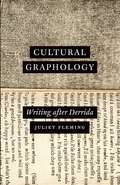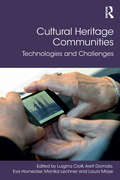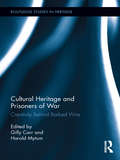- Table View
- List View
Cultural Convergence: The Dublin Gate Theatre, 1928–1960
by Ondřej Pilný Ian R. Walsh Ruud van den BeukenBased on extensive archival research, this open access book examines the poetics and politics of the Dublin Gate Theatre (est. 1928) over the first three decades of its existence, discussing some of its remarkable productions in the comparative contexts of avant-garde theatre, Hollywood cinema, popular culture, and the development of Irish-language theatre, respectively. The overarching objective is to consider the output of the Gate in terms of cultural convergence – the dynamics of exchange, interaction, and acculturation that reveal the workings of transnational infrastructures.
Cultural Criminology: Theories of Crime (The\library Of Essays In Theoretical Criminology Ser.)
by Jeff Ferrell Keith HaywardCultural criminology has now emerged as a distinct theoretical perspective, and as a notable intellectual alternative to certain aspects of contemporary criminology. Cultural criminology attempts to theorize the interplay of cultural processes, media practices, and crime; the emotional and embodied dimensions of crime and victimization; the particular characteristics of crime within late modern/late capitalist culture; and the role of criminology itself in constructing the reality of crime. In this sense cultural criminology not only offers innovative theoretical models for making sense of crime, criminality, and crime control, but presents as well a critical theory of criminology as a field of study. This collection is designed to highlight each of these dimensions of cultural criminology - its theoretical foundations, its current theoretical trajectories, and its broader theoretical critiques-by presenting the best of cultural criminological work from the United States, Europe, Australia, and elsewhere.
Cultural Dance in Australia: Essays on performance contexts beyond the Pale
by Jeanette MollenhauerThis book draws on theories of aesthetics, post-colonialism, multiculturalism and transnationalism to explore salient aspects of perpetuating traditional dance customs in diaspora. It is the first book to present a broad-ranging analysis of cultural dance in Australia. Topics include adaptation of dance customs within a post-migration context, multicultural festivals, prominent performers, historiographies and archives, and the relative positionings of cultural and Western theatrical dance genres. The book offers a decolonized appraisal of dance in Australia, critiquing past and present praxes and offering suggestions for the future. Overall, it underscores the highly variegated nature of the Australian dance landscape and advocates for greater recognition of amateur community dance practices. Cultural Dance in Australia makes a substantial contribution to the catalogue of work about immigrants and cultural dance styles that continue to be preserved in Australia. This book will be of interest to scholars of dance, performance studies, migration studies and transnationalism.
Cultural Data Science: An Introduction to R (Quantitative Methods in the Humanities and Social Sciences)
by Harald KlinkeThis book addresses growing demand in the visual humanities for foundational knowledge in data analysis, image processing, and artificial intelligence. Intended for readers without prior technical knowledge, its eighteen chapters introduce key concepts in data science through examples from art history, visual computing, and cloud technologies. For advanced readers, it explores how digital methods enhance our understanding of our cultural past. Focusing on image-based humanities research, the book demonstrates practical applications using open source software such as R, RStudio, and ImageMagick, along with open data sets from institutions like the MoMA, the Met, and the Rijksmuseum. Ideal for students, researchers, and professionals in art history, digital humanities, and museum studies, this book bridges the gap between technology and the humanities, making complex digital methods accessible to a broad audience.
Cultural Difference and Material Culture in Middle English Romance: Normans and Saxons
by Dominique BattlesThis book explores how the cultural distinctions and conflicts between Anglo-Saxons and Normans originating with the Norman Conquest of 1066 prevailed well into the fourteenth century and are manifest in a significant number of Middle English romances including King Horn, Havelok the Dane, Sir Orfeo, Sir Gawain and the Green Knight, and others. Specifically, the study looks at how the material culture of these poems (architecture, battle tactic, landscapes) systematically and persistently distinguishes between Norman and Anglo-Saxon cultural identity. Additionally, it examines the influence of the English Outlaw Tradition, itself grounded in Anglo-Saxon resistance to the Norman Conquest, as expressed in specific recurring scenes (disguise and infiltration, forest exile) found in many Middle English romances. In the broadest sense, a significant number of Middle English romances, including some of the most well-read and often-taught, set up a dichotomy of two ruling houses headed by a powerful lord, who compete for power and influence. This book examines the cultural heritage behind each of these pairings to show how poets repeatedly contrast essentially Norman and Anglo-Saxon values and ruling styles.
Cultural Diplomacy and the Heritage of Empire: Negotiating Post-Colonial Returns (Routledge Studies in Culture and Development)
by Cynthia ScottCultural Diplomacy and the Heritage of Empire analyzes the history of the negotiations that led to the atypical return of colonial-era cultural property from the Netherlands to Indonesia in the 1970s. By doing so, the book shows that competing visions of post-colonial redress were contested throughout the era of post-World War II decolonization. Considering the danger this precedent posed to other countries, the book looks beyond the Dutch-Indonesian case to the “Elgin (Parthenon) Marbles” and “Benin Bronzes” controversies, as well as recent developments relating to returns in France and the Netherlands. Setting aside the “universalism versus nationalism” debate, Scott asserts that the deeper meaning of post-colonial cultural property disputes in European history has more to do with how officials of former colonial powers negotiated decolonization, while also creating contemporary understandings of their nations’ pasts. As a whole, the book expands the field of cultural restitution studies and offers a more nuanced understanding of the connections drawn between postcolonial national identity making and the extension of cultural diplomacy. Cultural Diplomacy and the Heritage of Empire offers a new perspective on the international influence of the UNGA and UNESCO on the return debate. As such, the book will be of interest to scholars, students and practitioners engaged in the study of cultural property diplomacy and law, museum and heritage studies, modern European history, post-colonial studies and historical anthropology.
Cultural Diplomacy in Cold War Finland: Identity, Geopolitics and the Welfare State (Palgrave Macmillan Series in Global Public Diplomacy)
by Louis ClercThis open access book explores the organization and evolution of Finland’s Cold War cultural diplomacy (1945-1975) as the basis for a reflection on the country’s foreign relations, the link between culture and politics, small states’ autonomy during the Cold War, and the porosity of the East-West divide.The book offers a historical survey of the development of Finland’s cultural diplomacy as part of the Finnish state’s foreign activities. In its empirical parts, it focuses on archives drawn from the Finnish Ministry of Foreign Affairs and the Ministry of Education in order to explain Finland’s cultural diplomacy as the result of the country’s foreign policy orientations, interactions between domestic and foreign policy, and the expansion of state activities in the artistic, educational, and cultural sectors. Various reflections and reports on foreign cultural relations highlight the role of identity concerns, cultural relations, geopolitics and economic imperatives in the development of a specifically Finnish cultural diplomacy. Furthermore, the book focuses on specific aspects and events, considering for instance the organization and evolutions of Finland’s cultural relations with the USSR, the role of cultural treaties, academic exchanges and scientific cooperation, “cultural exports” and the marketization of culture, overlaps between cultural relations and high politics.
Cultural Diversity in the Armed Forces: An International Comparison (Cass Military Studies)
by Joseph Soeters Jan van der MeulenThis volume explores ethnicity and gender developments in relation to the military. In some countries, the armed forces have a long history in responding to ethnic diversity, while elsewhere it has come up only recently as a policy issue. An even-handed representation of ethnic minorities in the military is recognized as crucial for enhancing its social legitimacy and professional quality. The same can be said about the integration of women in the military, which during a few decades across the board has grown into more than just another issue of personnel policies. Indeed with regard to gender, the symbolism and sensitivities surrounding core identities are at stake – as with the presence of gays and lesbians in the military. Written by experts in the field, the chapters cover fourteen countries around the world: the USA, Canada, Bolivia, Ecuador, Brazil, South-Africa, Eritrea, India, Israel, Great Britain, France, Germany, Belgium and The Netherlands. Taken together, the armed forces of these countries offer a fascinating mix of similarities and differences in the ways they try to manage cultural diversity. Cultural Diversity in the Armed Forces will be of interest to students and scholars of military studies, sociology, gender and political science.
Cultural Economics (China Perspectives)
by Li YiningCulture is a priceless inheritance and source of wellbeing that is of immense value to humankind. Cultural economics set out to examine the nature and social benefits of cultural products and phenomena as they exist in the market. This volume is the masterpiece of Li Yining, one of the best-known Chinese economists, active in devoting his attention to the role of culture in the economy since the 1950s. Considering the importance of culture in the development of socialism with Chinese characteristics, the author combines cultural history, economic history, and the history of economic thought to produce unique perspectives. This book not only introduces the central concepts of cultural economics and the culture industry, but proposes several groundbreaking views that greatly influenced the culture policies of China, including cultural adjustment, cultural confidence, and cultural checks and balances. Researchers and students of economics, cultural studies, and Chinese politics, as well as policy makers, will benefit from this volume.
Cultural Economies of the Atlantic World: Objects and Capital in the Transatlantic Imagination (Routledge Studies in Eighteenth-Century Cultures and Societies)
by Victoria Barnett-WoodsCultural Economies explores the dynamic intersection of material culture and transatlantic formations of "capital" in the long eighteenth century. It brings together two cutting-edge fields of inquiry—Material Studies and Atlantic Studies—into a generative collection of essays that investigate nuanced ways that capital, material culture, and differing transatlantic ideologies intersected. This ambitious, provocative work provides new interpretive critiques and methodological approaches to understanding both the material and the abstract relationships between humans and objects, including the objectification of humans, in the larger current conversation about capitalism and inevitably power, in the Atlantic world. Chronologically bracketed by events in the long-eighteenth century circum-Atlantic, these essays employ material case studies from littoral African states, to abolitionist North America, to Caribbean slavery, to medicinal practice in South America, providing both broad coverage and nuanced interpretation. Holistically, Cultural Economies demonstrates that the eighteenth-century Atlantic world of capital and materiality was intimately connected to both large and small networks that inform the hemispheric and transatlantic geopolitics of capital and nation of the present day.
Cultural Encounters and Homoeroticism in Sri Lanka: Sex and Serendipity (Routledge Studies in the Modern History of Asia)
by Robert AldrichCeylon, or Sri Lanka, was long known to travellers for its luxuriant landscapes, colourful temples and friendly inhabitants – the island once named Serendip. This book explores the sojourns of gay visitors from the late 1800s to the modern day, providing a history of homosexuality, travel and cultural encounter on the island. The book offers profiles of major figures in Sri Lankan culture and of homosexual visitors, both famous and infamous, to the island. It discusses the experiences of sojourners including the Victorian social reformer Edward Carpenter and the German naturalist Ernst Haeckel, such British and American writers as Paul Bowles and Arthur C. Clarke, and the Australian painter Donald Friend. It also pays particular attention to Lionel Wendt, one of the most important modernist photographers outside Europe. For these figures, an erotic appreciation of young men whom they encountered mixed with interest in Sinhalese art, Buddhist and Hindu spirituality, and the flora and fauna of the island. Their experiences influenced modern writing, art and dance. Cultural influences moved in both directions, however, and Sri Lankans also found inspiration from abroad. The book argues that homosexuals played a major role in the transmission of cultural influences from Sri Lanka to the rest of the world, and from the wider world to this Indian Ocean island. Providing an original analysis of gay cultures in Sri Lanka from Victorian encounters to the present day, this book is the first study of Sri Lanka as a site of gay travel. An excellent study of trans-national cultural exchange, sexuality and the relationships between them, it will be of interest to academics in the field of Asian Studies, Colonial History and Gay and Queer Studies.
Cultural Encounters in India: The Local Co-workers of Tranquebar Mission, 18th to 19th Centuries
by Heike LiebauThe book is an English translation of an award winning German book. The history of social and religious encounter in 18th century South India is narrated through fascinating biographies and day to day lives of Indian workers in the Tranquebar Mission (1706-1845). The book challenges the notion that Christianity in colonial India was basically imposed from the outside. Liebau maintains that significant contributions were made by the local converts and mission co-workers who played an important role in the Tranquebar Mission.
Cultural Encounters in the Age of Globalism: 1945 to the Present
by Nicholas J. BarnettThis textbook examines encounters between different cultures during the Global Age, outlining their historical, social, political, and economic contexts. Based around themes including tourism, migration, protest, display of cultures, and the examination of ‘mega-events’ like the Olympics, the book explores the ways in which people were able to experience other cultures from 1945 onwards. The author questions the impact of these encounters, discussing whether they led to cultural hybridity or contrastingly, divergence. By bringing together a selection of themes and considering their national and transnational impact, this textbook provides insights for those studying international politics and global history. At a time when globalism is questioned by politicians and campaigners, this timely book examines its impact on groups of people and the systems under which they live.
Cultural Encounters on Byzantium's Northern Frontier, c. AD 500–700: Coins, Artifacts and History
by Andrei GandilaIn the sixth century, Byzantine emperors secured the provinces of the Balkans by engineering a frontier system of unprecedented complexity. Drawing on literary, archaeological, anthropological, and numismatic sources, Andrei Gandila argues that cultural attraction was a crucial component of the political frontier of exclusion in the northern Balkans. If left unattended, the entire edifice could easily collapse under its own weight. Through a detailed analysis of the archaeological evidence, the author demonstrates that communities living beyond the frontier competed for access to Byzantine goods and reshaped their identity as a result of continual negotiation, reinvention, and hybridization. In the hands of 'barbarians', Byzantine objects, such as coins, jewelry, and terracotta lamps, possessed more than functional or economic value, bringing social prestige, conveying religious symbolism embedded in the iconography, and offering a general sense of sharing in the Early Byzantine provincial lifestyle.
Cultural Entrenchment of Hindutva: Local Mediations and Forms of Convergence
by Daniela BertiThe book reflects on the discreet influence of Hindutva in situations/places outside or at the margins of its organisational and mobilisational arena, where people denying any commitment to the Sangh Parivar, incidentally, show affinities and parallelisms with its discourse and practice. This study looks at Hindutva’s entrenchment not so much as an orchestration from above but more as an outcome of a process that evolves in relation to specific social and cultural milieus.The contributors analyse Hindutva’s entrenchment, emphasising on the ethnography of the forms of mediation and/or convergence produced in certain contexts. The 11 case studies highlight three different dynamics of Hindutva’s cultural entrenchment. The first section gathers cases where RSS-affiliated organisations have set up specific cultural or artistic programmes at the regional level, involving the meditation of local people whose interest in these programmes does not necessarily mean that they endorse the Hindutva agenda completely. The next deals with convergence and refers to cases where the followers gather around a charismatic personality, whose precepts and practice may bring them towards a closer affinity with the Hindutva programme. The last section deals with the contexts of resistance, where social milieus engaged in opposing Hindutva may, in fact, paradoxically, and even inadvertently, imbibe some of its ideas and practices in order to contest its claims.
Cultural Evolution: How Darwinian Theory Can Explain Human Culture And Synthesize The Social Sciences
by Alex MesoudiCharles Darwin changed the course of scientific thinking by showing how evolution accounts for the stunning diversity and biological complexity of life on earth. Recently, there has also been increased interest in the social sciences in how Darwinian theory can explain human culture. Covering a wide range of topics, including fads, public policy, the spread of religion, and herd behavior in markets, Alex Mesoudi shows that human culture is itself an evolutionary process that exhibits the key Darwinian mechanisms of variation, competition, and inheritance. This cross-disciplinary volume focuses on the ways cultural phenomena can be studied scientifically-from theoretical modeling to lab experiments, archaeological fieldwork to ethnographic studies-and shows how apparently disparate methods can complement one another to the mutual benefit of the various social science disciplines. Along the way, the book reveals how new insights arise from looking at culture from an evolutionary angle. Cultural Evolutionprovides a thought-provoking argument that Darwinian evolutionary theory can both unify different branches of inquiry and enhance understanding of human behavior.
Cultural Exchange
by Joseph ShatzmillerDemonstrating that similarities between Jewish and Christian art in the Middle Ages were more than coincidental, Cultural Exchange meticulously combines a wide range of sources to show how Jews and Christians exchanged artistic and material culture. Joseph Shatzmiller focuses on communities in northern Europe, Iberia, and other Mediterranean societies where Jews and Christians coexisted for centuries, and he synthesizes the most current research to describe the daily encounters that enabled both societies to appreciate common artistic values. Detailing the transmission of cultural sensibilities in the medieval money market and the world of Jewish money lenders, this book examines objects pawned by peasants and humble citizens, sacred relics exchanged by the clergy as security for loans, and aesthetic goods given up by the Christian well-to-do who required financial assistance. The work also explores frescoes and decorations likely painted by non-Jews in medieval and early modern Jewish homes located in Germanic lands, and the ways in which Jews hired Christian artists and craftsmen to decorate Hebrew prayer books and create liturgical objects. Conversely, Christians frequently hired Jewish craftsmen to produce liturgical objects used in Christian churches. With rich archival documentation, Cultural Exchange sheds light on the social and economic history of the creation of Jewish and Christian art, and expands the general understanding of cultural exchange in brand-new ways.
Cultural Exchange and Identity in Late Medieval Ireland: The English and Irish of the Four Obedient Shires (Cambridge Studies in Medieval Life and Thought #109)
by Sparky BookerIrish inhabitants of the 'four obedient shires' - a term commonly used to describe the region at the heart of the English colony in the later Middle Ages - were significantly anglicised, taking on English names, dress, and even legal status. However, the processes of cultural exchange went both ways. This study examines the nature of interactions between English and Irish neighbours in the four shires, taking into account the complex tensions between assimilation and the preservation of distinct ethnic identities and exploring how the common colonial rhetoric of the Irish as an 'enemy' coexisted with the daily reality of alliance, intermarriage, and accommodation. Placing Ireland in a broad context, Sparky Booker addresses the strategies the colonial community used to deal with the difficulties posed by extensive assimilation, and the lasting changes this made to understandings of what it meant to be 'English' or 'Irish' in the face of such challenges.
Cultural Exchange in Seventeenth-Century France and England
by Gesa StedmanGesa Stedman's ambitious new study is a comprehensive account of cross-channel cultural exchanges between seventeenth-century France and England, and includes discussion of a wide range of sources and topics. Literary texts, garden design, fashion, music, dance, food, the book market, and the theatre as well as key historical figures feature in the book. Importantly, Stedman concentrates on the connection between actual, material transfer and its symbolic representation in both visual and textual sources, investigating material exchange processes in order to shed light on the connection between actual and symbolic exchange. Individual chapters discuss exchanges instigated by mediators such as Henrietta Maria and Charles II, and textual and visual representations of cultural exchange with France in poetry, restoration comedies, fashion discourse, and in literary devices and characters. Well-written and accessible, Cultural Exchange in Seventeenth-Century France and England provides needed insight into the field of cultural exchange, and will be of interest to both literary scholars and cultural historians.
Cultural Genocide: Law, Politics, and Global Manifestations (Routledge Studies in Genocide and Crimes against Humanity)
by Jeffrey S. BachmanThis book explores concepts of Cultural genocide, its definitions, place in international law, the systems and methods that contribute to its manifestations, and its occurrences. Through a systematic approach and comprehensive analysis, international and interdisciplinary contributors from the fields of genocide studies, legal studies, criminology, sociology, archaeology, human rights, colonial studies, and anthropology examine the legal, structural, and political issues associated with cultural genocide. This includes a series of geographically representative case studies from the USA, Brazil, Australia, West Papua, Iraq, Palestine, Iran, and Canada. This volume is unique in its interdisciplinarity, regional coverage, and the various methods of cultural genocide represented, and will be of interest to scholars of genocide studies, cultural studies and human rights, international law, international relations, indigenous studies, anthropology, and history.
Cultural Globalization and Music
by Nadia Kiwan Ulrike Hanna MeinhofThis book is about South-North, North-South relations between Africa and Europe, presenting the personal narratives of musicians in different locations across Africa and Europe, and those of the people who constitute their networks within the wider artistic, cultural, and civil society milieus of globalizing societies.
Cultural Graphology: Writing after Derrida
by Juliet Fleming"Cultural Graphology" could be the name of a new human science: this was Derrida's speculation when, in the late 1960s, he imagined a discipline that combined psychoanalysis, deconstruction, and a commitment to the topic of writing. He never undertook the project himself but did leave two brief sketches of how he thought cultural graphology might proceed. In this book, Juliet Fleming picks up where Derrida left off. Using both his early and later thought, and the psychoanalytic texts to which it is addressed, to examine the print culture of early modern England, she drastically unsettles some key assumptions of book history. Fleming shows that the single most important lesson to survive from Derrida's early work is that we do not know what writing is. Channeling Derrida's thought into places it has not been seen before, she examines printed errors, spaces, and ornaments (topics that have hitherto been marginal to our accounts of print culture) and excavates the long-forgotten reading practice of cutting printed books. Proposing radical deformations to the meanings of fundamental and apparently simple terms such as "error," "letter," "surface," and "cut," Fleming opens up exciting new pathways into our understanding of writing all told.
Cultural Heritage Communities: Technologies and Challenges (Digital Research in the Arts and Humanities)
by Luigina Ciolfi Areti Damala Eva Hornecker Monika Lechner Laura MayeCultural heritage communities of interest have increasingly expanded from cultural heritage professionals to volunteers, special interest groups and independent citizen-led initiative groups. Digital technology has also increasingly impacted cultural heritage by affording novel experiences of it – it features in a number of activities for all the aforementioned groups, as well as acting as support for visitors to cultural heritage centres. With different degrees of formality and training, these communities are increasingly defining and taking ownership of what is of value to them, thus reconfiguring the care, communication, interpretation and validation of heritage. Digital technology has played a crucial role in this transformative process. In a fully international context, cultural heritage practitioners, community champions and academics from different fields of study have contributed to this book. Each chapter brings to the fore the multiple relationships between heritage, communities and technologies as a focus of study and reflection in an inclusive way. Contributions touch upon present and future opportunities for technology, as well as participatory design processes with different stakeholders. This book brings together ideas from different disciplines, cultures, methods and goals, to inspire scholars and practitioners involved in community heritage projects.
Cultural Heritage Management in Africa: The Heritage of the Colonized
by Webber Ndoro George Okello AbunguCultural Heritage Management in Africa explores the diversity of Africa’s cultural heritage by analysing how and why this heritage has been managed, and by considering the factors that continue to influence management strategies and systems throughout the African continent. Including contributions from prominent scholars and heritage professionals working across Africa, the volume presents critical, contemporary perspectives on the state of heritage in the area. Chapters analyse the practices that emanated from different colonial experiences and consider what impact these had – and continue to have – on the management of African heritage. It also critically examines the ideological influence of independence movements on the African continent’s management and remembering of heritage, and considers whether there are any differences in heritage management between countries that experienced armed conflicts and those that did not. The volume will be the first to critically assess the state of heritage management now, at a time when vital conversations about the balance between heritage and development is ongoing and the actions of new players have begun to impact the management and practice of heritage in the region. Cultural Heritage Management in Africa will be essential reading for those engaged in the study of museums and heritage, development, archaeology, anthropology, history and African studies. It will also be of interest to heritage and museum professionals who wish to learn more about the decolonisation of heritage.
Cultural Heritage and Prisoners of War: Creativity Behind Barbed Wire
by Harold Mytum Gilly CarrThis book focuses on the numerous examples of creativity produced by POWs and civilian internees during their captivity, including: paintings, cartoons, craftwork, needlework, acting, musical compositions, magazine and newspaper articles, wood carving, and recycled Red Cross tins turned into plates, mugs and makeshift stoves, all which have previously received little attention. The authors of this volume show the wide potential of such items to inform us about the daily life and struggle for survival behind barbed wire. Previously dismissed as items which could only serve to illustrate POW memoirs and diaries, this book argues for a central role of all items of creativity in helping us to understand the true experience of life in captivity. The international authors draw upon a rich seam of material from their own case studies of POW and civilian internment camps across the world, to offer a range of interpretations of this diverse and extraordinary material.

